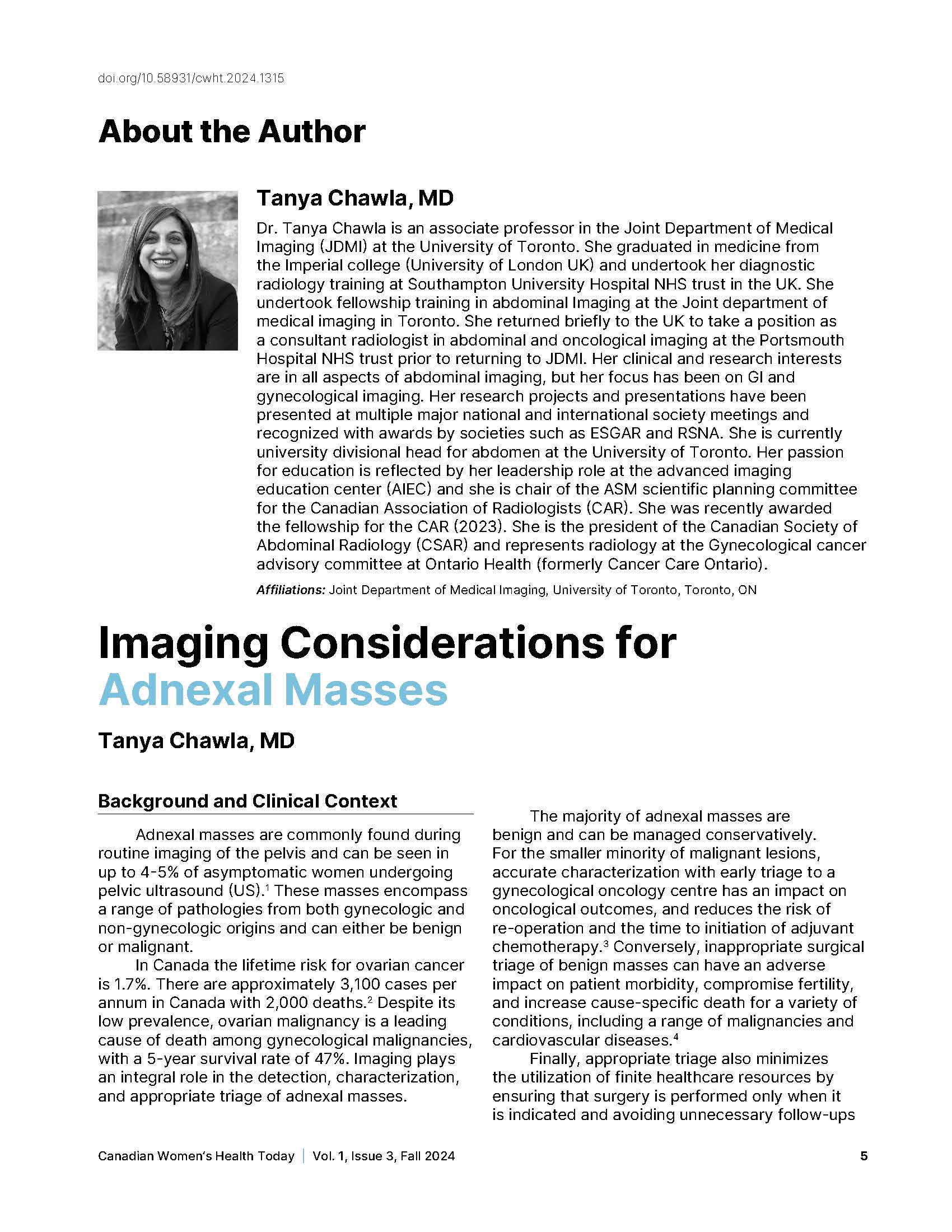Imaging Considerations for Adnexal Masses
DOI:
https://doi.org/10.58931/cwht.2024.1315Abstract
Adnexal masses are commonly found during routine imaging of the pelvis and can be seen in up to 4-5% of asymptomatic women undergoing pelvic ultrasound (US). These masses encompass a range of pathologies from both gynecologic and non-gynecologic origins and can either be benign or malignant.
In Canada the lifetime risk for ovarian cancer is 1.7%. There are approximately 3,100 cases per annum in Canada with 2,000 deaths. Despite its low prevalence, ovarian malignancy is a leading cause of death among gynecological malignancies, with a 5-year survival rate of 47%. Imaging plays an integral role in the detection, characterization, and appropriate triage of adnexal masses.
The majority of adnexal masses are benign and can be managed conservatively. For the smaller minority of malignant lesions, accurate characterization with early triage to a gynecological oncology centre has an impact on oncological outcomes, and reduces the risk of re-operation and the time to initiation of adjuvant chemotherapy. Conversely, inappropriate surgical triage of benign masses can have an adverse impact on patient morbidity, compromise fertility, and increase cause-specific death for a variety of conditions, including a range of malignancies and cardiovascular diseases.
References
Patel-Lippmann KK, Wasnik AP, Akin EA, Andreotti RF, Ascher SM, Brook OR, et al. ACR Appropriateness Criteria® clinically suspected adnexal mass, no acute symptoms: 2023 update. J Am Coll Radiol. 2024;21(6s):S79-s99. doi:10.1016/j.jacr.2024.02.017
Valentin L, Hagen B, Tingulstad S, Eik-Nes S. Comparison of ‘pattern recognition’ and logistic regression models for discrimination between benign and malignant pelvic masses: a prospective cross validation. Ultrasound Obstet Gynecol. 2001;18(4):357-365. doi:10.1046/j.0960-7692.2001.00500.x
Lai HW, Lyu GR, Kang Z, Li LY, Zhang Y, Huang YJ. Comparison of O-RADS, GI-RADS, and ADNEX for diagnosis of adnexal masses: an external validation study conducted by junior sonologists. J Ultrasound Med. 2022;41(6):1497-1507. doi:10.1002/jum.15834
Jha P, Gupta A, Baran TM, Maturen KE, Patel-Lippmann K, Zafar HM, et al. Diagnostic Performance of the Ovarian-Adnexal Reporting and Data System (O-RADS) ultrasound risk score in women in the United States. JAMA Netw Open. 2022;5(6):e2216370. doi:10.1001/jamanetworkopen.2022.16370
Van Calster B, Van Hoorde K, Valentin L, Testa AC, Fischerova D, Van Holsbeke C, et al. Evaluating the risk of ovarian cancer before surgery using the ADNEX model to differentiate between benign, borderline, early and advanced stage invasive, and secondary metastatic tumours: prospective multicentre diagnostic study. BMJ. 2014;349:g5920. doi:10.1136/bmj.g5920
Hack K, Gandhi N, Bouchard-Fortier G, Chawla TP, Ferguson SE, Li S, et al. External validation of O-RADS US Risk Stratification and Management System. Radiology. 2022;304(1):114-120. doi:10.1148/radiol.211868
Salvador S, Scott S, Glanc P, Eiriksson L, Jang JH, Sebastianelli A, et al. Guideline No. 403: initial investigation and management of adnexal masses. J Obstet Gynaecol Can. 2020;42(8):1021-1029.e1023. doi:10.1016/j.jogc.2019.08.044
Canadian Cancer Society. Ovarian cancer statistics 2024 [updated May 2024]. Available from: https://cancer.ca/en/cancer-information/cancer-types/ovarian/statistics.
Bouchard-Fortier G, Gien LT, Sutradhar R, Chan WC, Krzyzanowska MK, Liu SL, et al. Impact of care by gynecologic oncologists on primary ovarian cancer survival: a population-based study. Gynecol Oncol. 2022;164(3):522-528. doi:10.1016/j.ygyno.2022.01.003
Andreotti RF, Timmerman D, Strachowski LM, Froyman W, Benacerraf BR, Bennett GL, et al. O-RADS US risk stratification and management system: a consensus guideline from the ACR Ovarian-Adnexal Reporting and Data System Committee. Radiology. 2020;294(1):168-185. doi:10.1148/radiol.2019191150
Strachowski LM, Jha P, Phillips CH, Blanchette Porter MM, Froyman W, Glanc P, et al. O-RADS US v2022: an update from the American College of Radiology’s Ovarian-Adnexal Reporting and Data System US Committee. Radiology. 2023;308(3):e230685. doi:10.1148/radiol.230685
Buys SS, Partridge E, Greene MH, Prorok PC, Reding D, Riley TL, et al. Ovarian cancer screening in the Prostate, Lung, Colorectal and Ovarian (PLCO) cancer screening trial: findings from the initial screen of a randomized trial. Am J Obstet Gynecol. 2005;193(5):1630-1639. doi:10.1016/j.ajog.2005.05.005
Hiett AK, Sonek JD, Guy M, Reid TJ. Performance of IOTA Simple Rules, Simple Rules risk assessment, ADNEX model and O-RADS in differentiating between benign and malignant adnexal lesions in North American women. Ultrasound Obstet Gynecol. 2022;59(5):668-676. doi:10.1002/uog.24777
Timmerman D, Van Calster B, Testa A, Savelli L, Fischerova D, Froyman W, et al. Predicting the risk of malignancy in adnexal masses based on the Simple Rules from the International Ovarian Tumor Analysis group. Am J Obstet Gynecol. 2016;214(4):424-437. doi:10.1016/j.ajog.2016.01.007
Valentin L. Prospective cross-validation of Doppler ultrasound examination and gray-scale ultrasound imaging for discrimination of benign and malignant pelvic masses. Ultrasound Obstet Gynecol. 1999;14(4):273-283. doi:10.1046/j.1469-0705.1999.14040273.x
Mytton J, Evison F, Chilton PJ, Lilford RJ. Removal of all ovarian tissue versus conserving ovarian tissue at time of hysterectomy in premenopausal patients with benign disease: study using routine data and data linkage. BMJ. 2017;356:j372. doi:10.1136/bmj.j372
Timmerman D, Testa AC, Bourne T, Ameye L, Jurkovic D, Van Holsbeke C, et al. Simple ultrasound-based rules for the diagnosis of ovarian cancer. Ultrasound Obstet Gynecol. 2008;31(6):681-690. doi:10.1002/uog.5365
Timmerman D, Schwärzler P, Collins WP, Claerhout F, Coenen M, Amant F, et al. Subjective assessment of adnexal masses with the use of ultrasonography: an analysis of interobserver variability and experience. Ultrasound Obstet Gynecol. 1999;13(1):11-16. doi:10.1046/j.1469-0705.1999.13010011.x
Cao L, Wei M, Liu Y, Fu J, Zhang H, Huang J, et al. Validation of American College of Radiology Ovarian-Adnexal Reporting and Data System Ultrasound (O-RADS US): Analysis on 1054 adnexal masses. Gynecol Oncol. 2021 Jul;162(1):107–12.

